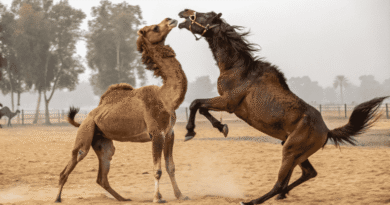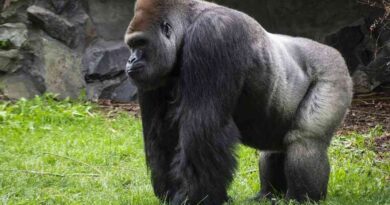Camel
The camel is the only truly large animal capable of surviving in the desert’s hot weather. Smaller desert species, such as rats and mice, can hide in tunnels beneath the surface to avoid the heat of the day. They only have to come up at night, when it’s lovely and cool. They can then move around freely. However, the camel’s massive body must be able to stand the sun’s harsh glare, hour after hour, every day. How does it manage this? The camel has a hump, and many people think that this hump stores water. The concept is that as the sun climbs higher in the sky, the camel will be able to quench its thirst by using its secret water supply. Despite the fact that this myth has been passed down for generations, it is simply not true. There is no particular water source in the camel’s hump or anywhere else. It avoids overheating in an entirely different manner.
The hump’s true power lies in its ability to function as a barrier, lessening the harm caused by the hot sun blasting down from above. It has a lot of fat in it, and fat isn’t particularly good at enabling heat to move through it. As a result, this “heat shield” that rests on top of the camel’s back protects the more sensitive organs inside the animal’s body. This also explains why the camel’s body seems to be so slim when viewed from the front or behind. Because of its narrow, upright design, it exposes significantly less of its surface to the sun’s rays during the midday hours, when the sun is directly overhead and at its hottest.
The cooling effect would be lost if the camel’s fat was spread out all over its body, as it is in many other animals, rather than heaped up in a big hump on its back. Rather than acting as a sun bonnet, its fat would act as a hefty, wrap-around overcoat. Rather than lowering the body temperature, it would raise it. The fat inside the hump provides an extra food supply when times are hard, in addition to acting as a sun-shield. When food is plentiful, many different kinds of animals store up layers of fat beneath their skin, which they later use when food is scarce.
When you have a lot of fat on your body, it’s like having a portable larder that you can raid when you need emergency food. The camel need more than just a hump and a slender body to shield itself from the desert sun, which can reach temperatures of more than 50°C (or more than 120°F). The second secret is that it can change its body temperature without suffering harm. If you’ve ever had a fever and been in bed, you know that as your temperature rises to around 38.5°C, you start to feel awful. Humans can only tolerate relatively slight temperature changes without becoming uncomfortable. This has been overcome by the camel in some way. It can allow its body to heat up to an incredible 40.5°C without breaking a sweat on a hot day. It can let its body cool down to as low as 35°C without suffering a chill during the frigid night.
The camel’s body can receive more and more heat during the day and lose it at night because of this ability. Then it’s ready to be cooked up all over again the next morning. If it couldn’t do that, it’d have to pant and sweat like other animals to stay cool. However, panting and sweating both result in water loss, which the camel cannot afford. The desert is not only hot, but extremely dry, and camels must sometimes go for days without drink while trekking across the bleak, sandy wastelands. If they are to survive, they must avoid losing any water. They would swiftly dry out, shrivel, and collapse if they cooled themselves by sweating like we do. It is so important for a camel to lose as little water as possible when crossing a desert that it will not even allow itself to generate urine. Urination is important because it signifies the removal of waste from the body, but it also entails a significant amount of water loss since the waste must be rinsed away from the body. The camel cannot afford to lose this much water, therefore it must dispose of its waste in a unique manner. It can bypass its kidneys and instead transfer all of its waste matter into its stomach when it becomes extremely hot. It can get rid of all the toxic compounds in its body as dry droppings and almost completely avoid passing pee this way. When camels do manage to reach a valuable pool of water at an oasis, they drink voraciously, consuming up to 90 litres in a matter of minutes.
This is roughly the same amount of liquid that it takes to fill a Rolls-petrol Royce’s tank, but there is a distinction. With one of these fillings, the Rolls could only travel for about a day, but the camel could travel for over two weeks before needing to drink again. In the desert, the camel is the Rolls-Royce. A third issue arises when travelling across desert terrain. Not only is it extremely hot and dry, but the ground is also extremely soft. Walking is hard due to the changing sands. On sandy wastes, horses tyres quickly. A specific kind of foot is required: one that is large, flat, and soft, which is another of the camel’s distinguishing characteristics. With their massive feet plodding across vast desert wastelands, they enabled ancient peoples to establish new trade routes all over the Middle East, and they played a crucial part in the development of early civilizations. Despite the camel’s outstanding ability to cope with the challenges of desert body, it has not been regarded as a noble animal in the same way as the horse has. When confronted with a camel for the first time, many people have reacted disgust. It has been described as dirty, noisy, obstinate, foolish, and unattractive. This is unjust to a gorgeous animal capable of incredible feats of survival.
True, it stinks, but even that characteristic has been put to good use in combat. It was observed in ancient battles that a troop of camels could terrify and scatter a troop of horses simply because the horses couldn’t stand their stench. The camel is likewise noisy and rebellious, but this is due to the fact that, unlike the meek horse, it does not appreciate being schooled and dominated by humans. And it’s just their unwillingness to do every work their owners assign that makes them appear foolish. It’s a matter of taste whether they’re attractive or not. They may not look their best in a zoo or a circus, but on the desert dunes, striding elegantly along, they have a dramatic style all their own. Furthermore, if you look closely enough, you will notice that the camel has a unique face. Even its harshest enemies would have to concede that it has the most beautiful eyelashes in the entire animal kingdom, despite the fact that some people find it repulsive.
This is no coincidence, because camels’ eyes require specific protection in the desert, where sand is frequently thrown around by powerful winds and catastrophic sandstorms can occur. The massive lashes thus operate as a shield, protecting the delicate eye surfaces from injury. The camel’s ability to close its nostrils securely also protects it from sandstorms. When fully open, they display large nasal chambers; however, when sand blows through the air, unique valves close them down to slits, keeping the cavities off from the outside world. Huge, rubbery lips lie behind the large nose. The camel’s upper lip is split into two pieces, and its mouth is incredibly flexible, allowing it to feed on tough, frequently spiky vegetation. It has the ability to eat trees and shrubs that no other animal would attempt to eat. It can reach out with its long, curving neck to find even the tiniest leaf or stem.
Only the behaviour of domesticated camels that have gone wild and began to fend for themselves in isolated regions provides insight into the camel’s social life. These animals congregate in tiny herds, each with a dominant male and six to twenty females. The lesser males establish bachelor groups and stay together until one of them feels brave enough to challenge the herd-master. Then a major fight can ensue, with each man attempting to appear as ferocious as possible. The short tail is swished as the combat begins, and the neck is lowered and then elevated.
Something unusual happens as a result of this. Males drool and gobble, inflating the insides of their mouths like giant rubber balloons. Their mouths practically turn inside out, with large rubbery flesh balloons hanging down and out of their mouths in a shocking threat show. Because of the gobbling noise the showing animals make, the balloon is called a “goulla.”
One camel eventually assaults the other, attacking the opponent’s legs and, in particular, his neck. The major goal is to keep the enemy’s neck pressed to the ground by holding it down with the camel’s own neck. If successful, the rival’s entire body will be forced down onto the ground, where it will be squished beneath the weight of the victorious winner.
Natural camel-fighting of this type used to be a regular sight in Turkey, where it was turned into an organised spectacle. However, due to the harshness of this so-called sport, it was prohibited in 1967.
Today, there are two kinds of camels. They are the thick-coated Bactrian camel from Central Asia’s deserts, which has two humps, and the slender Arabian camel from North Africa and the Middle East, which only has one. It’s always a good idea to inquire, “One hump or two?” if you’re asked to ride a camel, because it’s much easier to sit between the two humps of the Bactrian than it is to perch on top of the single hump of the Arabian. Despite this, the Arabian is the most well-trained racing animal. The ‘thoroughbred’ racing camel is known as a dromedary, and the speeds and distances it can travel are incredible. It can outrun even the fastest racehorse over great distances. Our bodies are better at staying in the saddle while the animals are at full gallop, hence the jockeys are usually very young lads. Camels were domesticated for the first time around 6,000 years ago. Their primary function has always been to transport huge loads over long distances, but they have also been ridden and even tied to the plough and used to tile the fields. Camels have not become extinct as a result of the later entrance of machines for transportation and farm labour.
Despite the fact that nearly all of the really wild camels have perished, there are still a large number of domesticated camels, some of which have escaped and formed wandering herds.
It is estimated that there are approximately 14 million domesticated camels alive today. Around 90% of them are Arabian camels with one hump. North Africa, the Middle East, Asia, and sections of Australia are all home to them. They will very certainly all be replaced by modern machinery one day, but for the time being, these hardy, long-suffering beasts may still be seen slowly, and occasionally with loud complaints, performing their many chores and duties. They may be a novelty to the modern tourist, but they remain a critical and sometimes life-saving servant for many people living in tough desert countries, capable of travelling 12 miles per day, week after week, month after month.
The camel is truly known as the “ship of the desert.”

